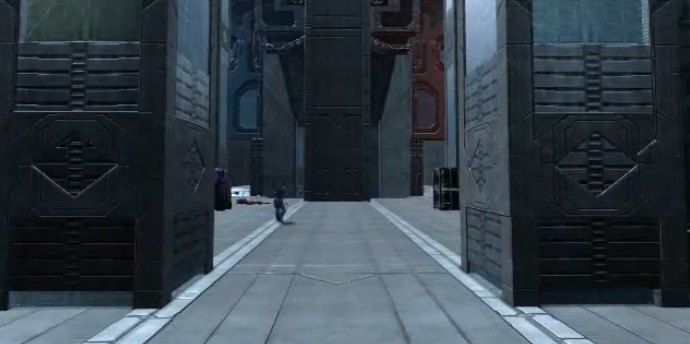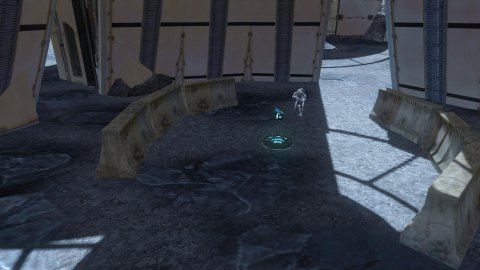Creating Immersion
There may be other ways to create an immersing environment in your map, but the best way I know of is through Theme. By forging a Theme into your map, you place the players somewhere. If they recognize the Theme, it becomes easier for them to feel like they are there. It helps them to see themselves where the Theme suggests.It is important to create a Theme that is new, yet very concise and obvious. The first map I saw that fit this was Affinity[1], which presented a Forerunner Theme.

The reason Affinity was such a success in this respect is that the Architecture was unified through out and it leveraged the Forerunner Theme of the Canvas’ palette. Playing the Theme of the Canvas’ palette adds strength to your map’s ability to immerse a player when it is working with you rather than against you.
Sustaining Immersion
Sometimes you need some extra scenery, like the barricades at the bottom of the central tower in Hekau, not to add cover, but to help the Theme come alive. The barricades at the bottom of the central tower make the central tower seem more realistic, because the way they are positioned in a circular pattern suggests that the ground level of the central tower has a purpose other than just being there for the sake of the map. The presence of the barricades suggest that the structure itself is used to protect whatever is in the center of the ground floor, and they do this by suggesting that they themselves are an inner wall of protection to that same end. The barricades can be used for cover, but their primary purpose is to deepen the immersion that a player experiences as they walk into the ground level of the central tower.
I also believe that leveraging the terrain helps a lot in creating a Theme for the purpose of immersing players. Given the textures on the blocks in any palette, the details of the Canvas really should be leveraged. If for no other reason, the terrain can help prevent repetitive, boring Architecture. On the other hand, the terrain becomes a part of your Architectural Theme – indeed, it becomes the foundation for your map’s Theme.
Breaking Immersion
It is much easier to break immersion than to create it or sustain it. Breaking immersion simply requires a flaw such that players see, do, or in some way experience something that they shouldn’t see, shouldn’t be able to do, or should never experience. And there are too many ways to accomplish any of these.From a visual perspective, anything that the player sees that looks out of place has the potential to pop the player out of immersion. One of the more difficult things you as a forger will face is to create a unified Theme through out your map where everything seems to belong to the Theme. But there are other ways to create visual features that break immersion.
Visual noise can distract a player so much that they can no longer feel like they are in the Game Play, because they are trying to process the map features. When Halo 4 came out, the first thing I realized was that each forge Canvas’ palette was full of noise. Needless to say, nearly every community map was visually noisy through out, and I dreaded playing on any of them just for that reason alone. I will talk more about visual noise in more detail later.
Structural detail can fail to line up, drawing the attention of a player to the fact that the blocks themselves are blocks.

Z-fighting can distract the player and remind him that the structure is made of forge blocks.
When the forging community began seriously forging for Reach’s Invasion, one approach they adopted to improving video rendering performance was the gating of blocks. Literally blocks would disappear when they were no longer needed. Not only did it kill immersion, it was simply the wrong way to achieve good video rendering performance. The proper way is to reduce the block count. If the map cannot be forged due to the blocks that would have to be removed, then the map becomes an impossibility. Altering the map’s Geometry is acceptable only when the Game Play lends to it – like when a wall is destroyed by a bomb exploding. Never gate blocks out of view.
And then there is the teleport. The teleport can be notorious for breaking immersion in a number of ways. You can instantly find yourself in a room that looks dramatically different than where you entered the teleport. You can sense a massive disorientation by utilizing the teleport. Where the teleport takes you can leave an unintuitive experience, like it really should have taken you somewhere else instead.
Teleports have a good purpose but you really need to utilize them judiciously and carefully. Teleports are an exercise in minimizing disorientation and as such require extra attention to how a player will perceive the overall experience. Pass through the teleport and stop on the receiver pad. Ask yourself What does the player see? Ask the correct questions.
The Symmetry Problem
The biggest problem with symmetrical maps is that by the very nature of their symmetry they look artificial. There are a few reflective translation maps that do symmetry proud and fully immerse the players into the Theme of the map despite their strict adherence to symmetrical design.Take Narrows for example. Have you taken the time to look out across the gorge? You would see another bridge structure spanning the gorge just like the one you are standing on. The bridge is fully symmetrical, and it works very well as a symmetrical map, because bridges are symmetrical in real life. The bridge structure off in the distance was put into the Canvas to help immerse the players on the bridge that forms the map.
And it isn’t enough to just create a bridge structure as a Narrows remake, for example. You need the full context of why the bridge is there. Forge in the gorge. Forge in another bridge structure way off in the distance if you have to. Take the time to build the Theme to give your map a context to immerse your players in.
Countdown, a rocket launch facility, has a fully reflective translation design using the center as a rocket exhaust well. The well gives the designer the opportunity to surround the well with rings of platforms in a fully symmetrical Architecture. The facility looks extremely believable as a result.
Haven looks sort of like an alien religious order site, and the circular hallway around the perimeter makes it look alien and gives all the reason to expect the map to be symmetrical. The symmetry fits the Architecture very well.
Summary
Forging a unified Theme through out your map is a good foundation for creating an immersing environment. Leveraging the Theme of the Canvas’ palette is also a good start.Additional scenery can be useful to sustaining immersion as players move about your map.
Anything out of place can break immersion, leading the player to feel like they woke up from playing in the game to playing a video game.
Symmetry aids in immersing players when symmetry is expected within the Theme of the map.
_______________________
[1] Affinity, Halo: Reach, by Godly Perfection
No comments:
Post a Comment
Note: Only a member of this blog may post a comment.